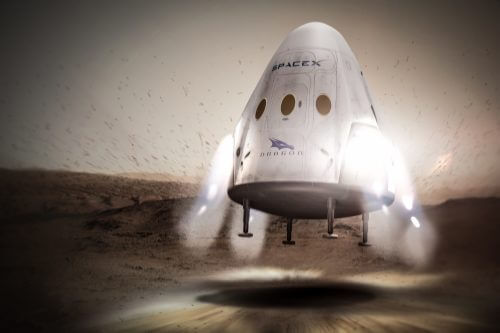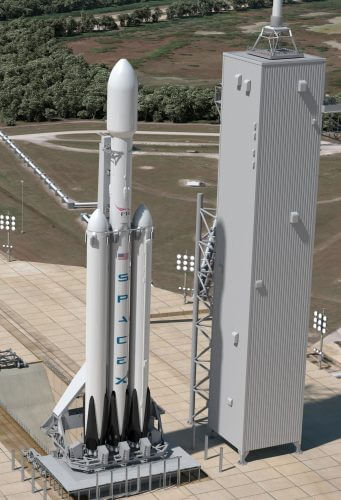SpaceX tweeted that it plans to send a Dragon spacecraft to Mars "by 2018 at the earliest." The mission will be unmanned and will be based on a proposal developed by NASA researchers for a scientific research mission that will utilize the spacecraft's ability to land using rocket engines on the Red Planet.

Elon Musk and the SpaceX company he heads They declared They intend to carry out the mission in 2018 at the earliest, as a test flight. Musk Wrote that "the spacecraft was designed to land anywhere in the solar system". By this, he refers to her unique ability to land vertically using only rocket engines, without the need to use parachutes.
NASA Deputy Administrator, Deva Newman, she said in published words In her blog on the NASA website, that the agency and SpaceX have signed a contract under which NASA will provide technological assistance to the company's efforts to land on Mars, and in return SpaceX will provide NASA with essential information regarding the data of the Dragon's landing on Mars, which will assist NASA in its missions Futures on Mars.
So far, vehicles launched before the planet have used a variety of methods to land safely on Mars – often using multiple methods on the same mission. For example, NASA's Curiosity rover, which landed on Mars in 2012, used a heat shield, parachutes, rocket engines and a special crane (sky crane) to land. One of the reasons that make a simple landing on Mars difficult is that its atmosphere is very thin (100 times more than Earth's).
SpaceX is developing these days A manned model of her Dragon spacecraft, which is now used to launch unmanned payloads to the International Space Station. The model, called "Dragon 2", will be used to send NASA astronauts to the International Space Station. The model will be equipped with 8 rocket engines produced by the company called SuperDraco, and allow the spacecraft to land accurately and simply on the ground. The spacecraft will also retain the ability to land using parachutes. In fact, in its first missions, which are planned to be carried out for the first time in about a year, the spacecraft will use parachutes and not a vertical landing with rockets, to avoid risking the lives of the astronauts with this new method.
Musk emphasized that the mission to Mars will be unmanned, and will be based on A proposal called "Red Dragon", which NASA researchers proposed as part of a relatively inexpensive mission to return a sample from Mars to Earth for thorough laboratory testing. Such a task has been considered of great scientific importance for many years, but it is considered very expensive, due to the need to use several different vehicles to complete it.
In the proposal made by the researchers, the task will be simpler and therefore cheaper. They proposed to use the manned model of Dragon that is being developed by SpaceX, to bring a payload weighing up to 2 tons to Mars, something that has not been done to date (the heaviest payload placed is the Curiosity rover which weighs XNUMX ton). In their research they found that the spacecraft could land on the red planet using its rocket engines. Another advantage of the spacecraft is its ability to land on many sites on Mars that today are impossible to reach, this is because due to the thin atmosphere of Mars, vehicles that land on its surface are forced to look for the lowest places on the planet, in order to gain additional height that will extend the duration of the landing and enable its execution. A dragon, on the other hand, will have no such limitation.

A mission to Mars will require a powerful launcher, more powerful than the Falcon launcher that the company currently has. This is what SpaceX is designating the heavy launcher it is developing, the "Falcon H" (Heavy Falcon), whose first test flight is planned for November this year. It will be quite similar to a regular Falcon launcher, but instead of a single first stage it will have three of them close together, with a single upper stage. It will be interesting to see how the first three stages land back together, as SpaceX plans to do in the framework Its attempts to create a multipurpose launcher.
SpaceX has not said whether it intends to tie the mission it is planning to a research mission as suggested by NASA researchers, but the ambitious and long-term intentions of the company, and of its founder Elon Musk, are not hidden. musk, who proposed not long ago to "bomb the atom" The icy poles of Mars as a quick method to ground it (that is, to make it similar in its conditions to the Earth), sees sending people to Mars as a long-term project of society. He stated that he sees this as an extremely important task, the goal of which is to make the human race multi-planetary and thereby maintain its survival. The company also plans to build a future space vehicle that can launch people to Mars and back, to establish a manned colony on Mars.
See more on the subject on the "Hidan" website:
- Elon Musk: There is a chance that within 10-12 years it will be possible to send humans to Mars
- Elon Musk introduced the first civilian manned spacecraft: SpaceX's Dragon V2

3 תגובות
The fastest way to land is to bombard Mars with life forms that can exist there
Evolution will do the rest
Finally the private market is starting to get into planetary research. In my estimation, engineering and technological breakthroughs will come from this, which are extremely essential when it comes to manned flights to Mars and other places in the solar system.